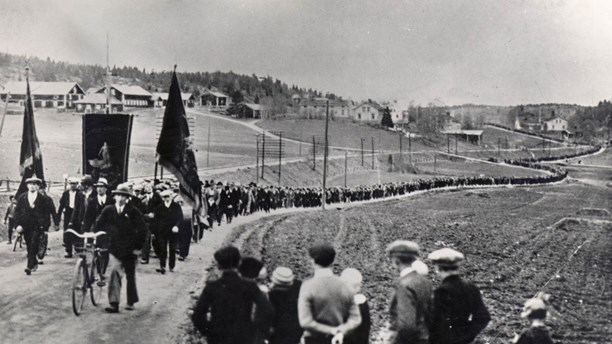Start date May 14, 1931 | ||
 | ||
dalen shootings
The Ådalen shootings (Swedish: skotten i Ådalen) was a series of events in and around the sawmill district of Ådalen, Kramfors Municipality, Ångermanland, Sweden, in May 1931. During a protest on May 14, five people were killed by bullets fired by troops called in as reinforcements by the police.
Contents
Background
As a response to a drawn-out industrial conflict over pay reductions at the pulp factory at Långrör, workers at other plants went on a sympathy strike. The owner of the Graninge company, Gerhard Versteegh, hired around 60 strike-breakers, who arrived in the village of Lunde in Ådalen on May 12. The workers held a peaceful protest rally in Kramfors and marched to the Sandviken plant north of the town, where they approached and attacked some of the strike-breakers. Since the police had not been able to stop the attack, the County Administrative Board asked for the deployment of members of the military from Sollefteå to protect the strike-breakers. When the troops arrived in the late evening of May 13, they were met by protesters, allegedly throwing stones.
Confrontation
On May 14 the unions held another rally, during which the attending workers decided to stop all work in the timber and pulp industries in Ådalen--a general strike. After the meeting, several thousand participants marched to the strike-breakers' quarters in Lunde, where the troops had been ordered to defend the strike-breakers. When they arrived in the village, a patrol of mounted troops tried unsuccessfully to stop them. In the confusion that followed, at least one man fell off his horse and another drew his pistol and fired warning shots while the patrol withdrew. The military commander, Capt. Nils Mesterton, said later that he believed the demonstrators carried weapons since he heard shots as well as seeing some of the mounted patrol bleeding. At a distance of less than 100 metres he ordered his troops to fire, which they did, aiming as planned at the ground halfway between the line and the demonstrators. However, ricochets hit the gathered demonstrators, who scattered, and the captain ordered the machine gun fired. Five people were shot to death: Oskar Berggren, Erik Bergström, Evert Nygren, Sture Larsson and Eira Söderberg, a 20-year-old bystander. Five people were injured. An inquiry later concluded that there was no evidence that the workers were in fact armed.
On that same day the County Administrative Board had decided to prohibit the strike-breakers from working. Their decision did not reach the demonstrators until after the shooting. It is widely believed that the confrontation could have been avoided if the news had reached the marchers earlier. The Swedish Employers' Association later asked the Swedish Parliamentary Ombudsmen to review the decision.
Aftermath
The events spawned a raging national debate, deeply divided along political lines. The political left called the shootings "murder", while the right claimed that the military had been forced to open fire to defend themselves and the "willing workers" from the rage of the demonstrators. The publishers of several left-wing newspapers were convicted for violations against the limitations in the Freedom of the Press Act. Major demonstrations took place in Stockholm.
The County Governor was tried in court but acquitted. Capt. Mesterton and Capt. Beckman were initially convicted in a court martial, but were acquitted on appeal and that verdict was confirmed by the supreme court. Sgt. Rask and Sgt. Tapper, who were manning the machine gun, were also put on trial since repositioning had been performed with a loaded weapon, which was against army regulations. Rask was acquitted while Tapper was found guilty and sentenced to three days' confined arrest with loss of pay. On the other hand, several demonstrators had to face severe sentences: Axel Nordström, considered to be the leader, was sentenced to 2-1/2 years' imprisonment with hard labor. No damages were awarded to the wounded demonstrators or to the families of the five dead.
The government, under the liberal Prime Minister Carl Gustaf Ekman, replaced the County Governor and launched an investigation into the event. The investigation, with representatives from both employers and trade unions, later concluded that the military was highly unfit to uphold public order in similar situations. The use of the military against civilians was more strictly regulated, but the legislation was on the books until it was repealed by the 1969 Riksdag. However, there was broad political agreement not to use military force against civilians. The Ådalen shootings were still a concern in the discussions after the 9/11 events in the US, when military support to the police was considered. Therefore, the subsequent legislation that allowed the military to take part in anti-terrorism actions contained several safeguards. The military must be under command of the police and legislation specifically says that the military cannot be used against demonstrations. There was still concern that these safeguards would not be enough.
At the time of the 1931 events, it was not possible to call in police reinforcements from outside the county. Thus, army assistance was the only recourse available to a county governor when the county's police force would be insufficient to deal with large-scale events. The shootings highlighted the inadequacy of this state of affairs. One effect of the Ådalen shootings was the formation of a national police force in 1933.
Coverage in film
In 1969 well-known Swedish filmmaker Bo Widerberg told the story of the events in his film Ådalen 31 (released as Adalen Riots in the US). Partly thanks to the film and partly through the persistent use of the events in political debate, the Ådalen shootings are still well known in Sweden, and are sometimes referred to in connection with violent clashes between demonstrators and police such as the 2001 EU summit protests in Gothenburg.
The incident is also mentioned several times in the 1979 Swedish comedy film Repmånad.
